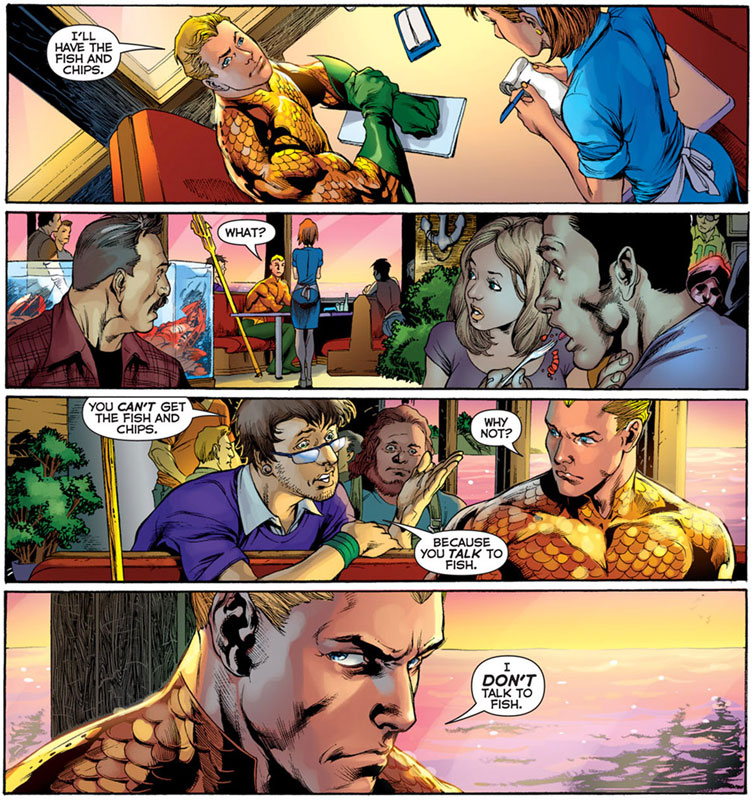By Geoff Johns, Doug Mahnke, Christian Alamy and Keith Champagne, Alex Sinclair, Sal Cipriano, Francis Manapul
I never got too far into the
Geoff Johns run of
Green Lantern, which makes me a lapsed reader of the title. Now I understand that Johns managed to fashion it into one of the cornerstones, if not The Keystone, of the DC Universe. He did this by generating a convoluted cosmology around the
Guardians of Oa and the
Green Lantern Corps that left me more disinterested in following the title. But when DC announced that their latest company-wide relaunch wasn't a reboot, they meant that certain titles, especially this one, would carry on more or less unaffected. In fact, several titles of the
New 52 universe start were the old Green Lantern storylines left off. How was this supposed to appeal to new readers?
Well, in the case of the core Green Lantern series, Johns harks back to an earlier and simpler era.
Hal Jordan has been kicked out of the Green Lantern Corps for actions that aren't explicated in any detail. Meanwhile, arch-villain
Sinestro has been reinstated as a Green Lantern. The first thing he does is travel to Earth to enlist the help of Hal, in order to liberate his home planet
Korugar from the clutches of the
Yellow Lanterns. As a reader I don't get why Sinestro is now fighting the very corps that he himself founded, but whatever. The point of the story is that Sinestro has gone back to treating Hal like a rookie under his wing again.
The character dynamic is similar to what longtime GL fans already knew about the duo (Or to viewers of the
GL movie). Sinestro is a condescending jerk who corrects every little mistake Hal makes, like not knowing how to properly save people from a collapsing bridge and whatnot. For his part, Hal acts nothing like the savvy veteran that he's supposed to be. Rather, he's a loser who can't hold down a job, maintain a steady relationship, or pay his rent on time. He wants so much to get back into the GLC, so he takes Sinestro up on his offer without hesitation, even if he hates his guts. If Johns is trying to make Hal a sympathetic character who's down on his luck, he doesn't succeed. There's one scene were he goes on a date with his on-off again girlfriend
Carol Ferris that sounds like it was meant to be funny, but falls flat when Hal asks Carol for financial help. Hal just comes across as a dumb fighter-jock instead of an experienced superhero. Actually, Sinestro goes out of his way to make fun of the "super-hero" label as well.
That Geoff Johns' GL continuity survived relatively intact is representative of the new DC Universe. It looks and feels a lot like the old Universe, just refurbished to get the attention of lapsed readers. And it shores up the already loyal fans. But it doesn't work as well opening up to a new audience. Johns loves organizing his cast into stark black and his white categories (i.e. the Sinestro Corps and the GLC), but he's not particularly adept at portraying subtle human interactions. This weakness mixes uneasily with his fetish for graphic violence. The results aren't so much intelligent and edgy as they are creepy and disturbing. The two main characters sometimes act like bickering teenagers. The wielders of the most versatile weapons in the universe use them mostly to torture, strangle or disembowel their enemies. The Guardians have no problem lobotomizing anyone who disagrees with them. And those are the people who are in charge of protecting the universe from evil?

In issue #4 Sinestro reaches a turning point. His plans to save Korugar have gone to pieces. He's trapped and cornered. Encouraged by Hal, he begins to admit his mistakes and asks for help from the people he sought to protect. Does this mark genuine change, or a red herring thrown in before Sinestro reverts back to true villainy? The problem is that having to choose between him and Hal kind of sucks.



